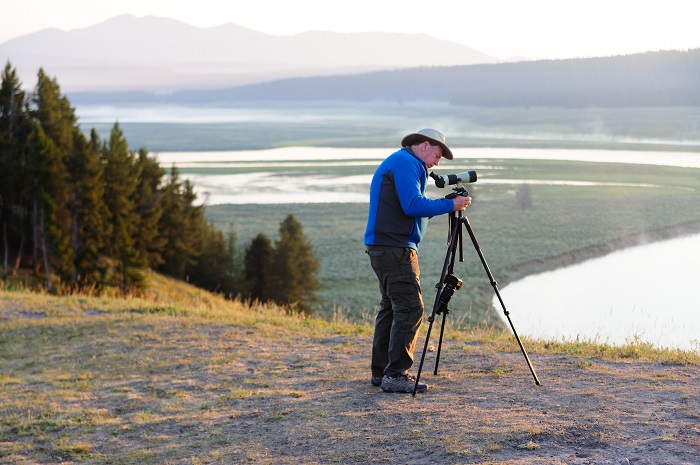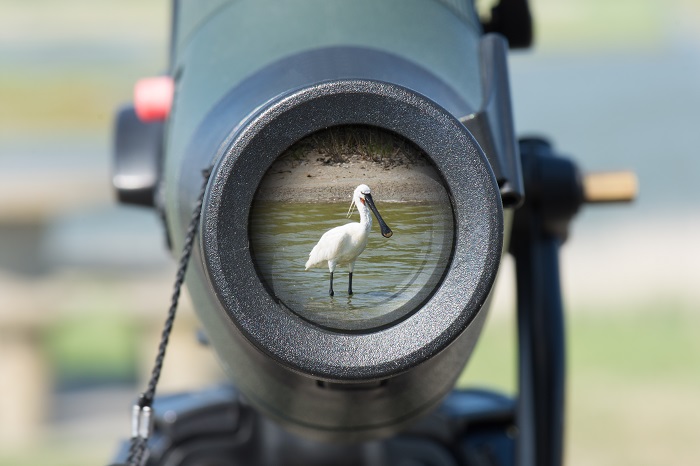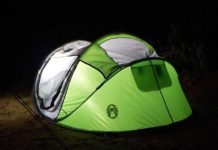Nature is outstanding, and enjoying its beauty is an ideal way to release stress after a long working time. Have you ever tried to immerse yourself in stunning nature by watching wild birds or animals?
Finding a lovely vista is simple, but seeing birds clearly can be difficult. We assume you once tried using a monocular, but it fell short of your expectations. We recognize your concern, which is why this monocular review is here.
This is must-have equipment if you are an outdoor enthusiast or bird watcher. A monocular is very compact and light in its powerful features. It allows you to see distant wildlife with astounding clarity.
Nowadays, it seems as though you can decide with ease because there are many monoculars available that are both high-quality and affordable. Though some offer more than simply an excellent optical prism, do you still hesitate to pick the best monocular?
As a result, don't miss this review if you're looking for the greatest monocular for your adventure. This article has compiled a list of the top 10 monoculars for seeing birds in 2024 for you to choose from.
Our Team's Picks
* Best crossover monocular for birdwatching, hunting & watching scenery: Gosky 12x55 High Definition Monocular
* Excellent field of view monocular: GAIWEI 8-20x50 High Power Zoom Monocular
* Best overall monocular for birdwatching: Vortex Optics Solo Monocular 8x36
* High power monocular with clear low light vision: Adasion 12x56 HD Monocular
* Deliver amazing images in all weather conditions: Bushnell Legend Ultra HD Monocular
* Best compact and sturdy monocular: Pankoo 40X60 Monocular
* Powerful zoom magnification range: Emarth High Power 10-30X50 Zoom Monocular
* Best wide-angle view monocular: ARPBEST 25X50 High Definition Monocular
* Compatible with all types of smartphone: Vabogu 12x50 High Power Monocular
* Best Budget Monocular: Archeer 16x52 Monocular
Monocular For Bird Watching Comparison Table
Monocular | Preview | Magnification | Rating |
|---|---|---|---|
 | 12X | 4.8/5 | |
 | 8X-20X | 5/5 | |
 | 8X | 4.9/5 | |
 | 12X | 4.7/5 | |
 | 10X | 4.8/5 | |
 | 40X | 4.6/5 | |
 | 10X-30X | 4.7/5 | |
 | 25X | 4.5/5 | |
 | 12X | 4.6/5 | |
 | 16X | 4.7/5 |
Monocular For Bird Watching Reviews
Before getting to the guide to choose a good monocular for bird watching, I've rounded up the most notable choices on the market.
1. Gosky 12x55 High Definition Monocular

With this incredible equipment, you can be fully prepared for your bird-watching activities, hunting, hiking, or any other outdoor activities, like concerts and athletic events. This 12x55 Gosky monocular not only has a competitive magnification of 12 x, but it also offers various handy functions to meet the demands of all outdoor enthusiasts.
This item includes a big multi-coated objective lens to improve light transmission and delivers a sharp and clear view field. In addition, the monocular has a high-quality multi-layer eyepiece and a modern BAK4 prism. Its manufacturer also includes the product with long eye relief and a twist-up eyecup.
Finally, this type features a strong and durable grip that prevents the object from sliding. The shock-absorbing armor can protect even if you accidentally drop its eyepiece. The unit is also fog-, water-, and dust-proof, allowing you to carry it anywhere you go.
Despite being significantly heavier than its counterparts, this model functions wonderfully, letting you observe distant things easily.
This model comes with a Gosky adapter, so you won't need to buy any extra accessories. The digiscoping adapter is compatible with almost all cell phones on the market.
PROS
CONS
2. GAIWEI 8-20x50 High Power Zoom Monocular

Immerse yourself in beautiful nature by hiking, hunting, or just looking around with a telescope. All these things are ideal ways to release stress and gain more energy.
With this GAIWEI monocular, you can observe everything in front of your eyes, making it excellent for hunting, hiking, bird watching, mountain climbing, stunning beaches, and competitive events.
Built-in huge BAK-4 prism in the monocular, multi-layer green objective lens coating - improves the monocular's primary function, making your eyesight brighter and clearer and offering crisp pictures.
This item also offers a 50mm FMC green film objective. As a result, you may see 8-20x up close for crisp and brilliant pictures, allowing for higher light brightness and transmittance.
The 8-20x magnification guarantees that you can receive the greatest possible perspective on your outdoor experiences, making distant objects look realistic in front of your eyes. This way, you will enjoy the natural beauty to the fullest.
PROS
CONS
3. Vortex Optics Solo Monocular 8x36

The 8x36 Vortex Solo Monocular is a lightweight, compact optic with completely multi-coated lenses that boost light resolution and transmission. As its name implies, this item features a 36mm objective lens with an 8x magnification. Thus, it can provide brighter and sharper pictures.
Moreover, the monocular is completely armored with rubber, which provides a non-slip grip and makes it exceptionally sturdy. The manufacturer also purges this product with Nitrogen and seals it with an o-ring to give it a waterproof and fog-proof capacity in various weather conditions.
Its adjustable eyecup allows for easy viewing with or without spectacles. This 36mm Solo comes with a helpful utility clip for easy attachment to your gear or apparel.
Although its close focus distance of about 16.4 feet is not the shortest on this list, it still suffices. The focus wheel of the Solo is positioned on the eyepiece. Simply turn it until you can see the objects clearly. Turn it clockwise to focus on distant items and counterclockwise to focus on stuff near you.
PROS
CONS
4. Adasion 12x56 HD Monocular

A huge 18mm BAK4 prism lens gives HD vision, a brighter perspective, and superb low-light vision in the modern fully multi-coated monocular. Dielectric coating and phase coating monoculars create high-contrast, clear, color-accurate pictures. Thus, it is perfect for animal/bird watching, nature viewing, camping, hiking, concerts, and sporting events.
Another must-mentioned advantage of this item is its large eyepiece of 21mm. Hence, it can offer a broader and more comfortable field of view.
A high-powered telescope features a magnification of up to 12x, a 56-mm objective diameter lens, and a field of vision of 325ft/1000yards. Thus, it offers the greatest view for stargazing and bird watching.
Of note, it includes a strong tripod in the package to guarantee sharper, brighter, and shake-free photos. With only one click, you can shoot photographs. This way, the beauty of the faraway globe may be effortlessly captured and shared with your buddies and family.
It's an excellent monocular with easy alignment, compatibility, stability, and portability. Indeed, it is suitable for all smartphone models, including iPhone, Sony, Samsung, Google, Motorola, LG, HTC, etc.
This lightweight monocular comes with a portable and convenient hand strap that prevents the monocular scope from sliding out of your grasp. In different climates and situations, the IPX7 Nitrogen-filled waterproof can provide fog-resistant, water-resistant, dust-resistant, and shock-resistant for protection.
PROS
CONS
5. Bushnell Legend Ultra HD Monocular

This Bushnell Legend Monocular is made of durable materials. It includes everything you need for your next birding excursion, including a magnetic-plate tripod mount, a lens cleaning disk, and a protective case.
In addition, this monocular offers an excellent 10x magnification that allows you to see distant objects in great detail. It's waterproof and lightweight (about 0.83 lbs), making it ideal for trekking or hunting in the forests. At 1000 yards, it has a 340-foot view field, so you can observe your target clearly before approaching it.
In detail, the dimensions of this model are 10.72 inches in length, 2.5 inches wide, and 3.24 inches in depth, making it tiny enough to carry in your pocket when attending outdoor activities. The 6.25-inch lens is easily adjustable to accommodate your eyesight.
It features a magnification of 10x and a 42-mm lens, larger than normal monocular lenses. That's why it can let you see items from a long distance. You only need to decide on a target. Using this Bushnell Legend, you can see objects up to a mile distant!
PROS
CONS
6. Pankoo 40X60 Monocular

The large lens comes with the B A K 4 prism and is entirely multi-coated. The bigger the objective lens is, the more light can enter the telescope to bring a brighter view. That's why it can produce detailed and extremely clear images without black bars.
The mirror contains high-purity nitrogen, is antifogging, and is waterproof. Moreover, the product has a small and strong housing that can survive heavy rain. Thus, it may be used on a rainy or humid day without danger of harm.
It has tripods and a smartphone holder for simple alignment. It works with smartphones, is easy to set up, has a remote control monocular, and delivers HD photos.
PROS
CONS
7. Emarth High Power 10-30X50 Zoom Monocular

The Emarth 10-30X50 High Power Zoom Monocular is another excellent pick. These monoculars vastly outperform previous versions.
First, its design and materials are amazing. This item is loaded with Nitrogen and repels dust, water, and fog. Because it is IPX7 certified, you may submerge it in water, and it will not only be air and waterproof, but it can also float.
With a simple turn of its eyepiece, you may zoom in and have several settings ranging from 10x to 30x. When coupled with the BAK4 Porro Prism, the 50mm lens delivers a broad field of vision and a superb image, and lens covers are supplied to preserve both.
In addition to many powerful features, this monocular is bigger and heavier than others. It also features a 1/4-inch tripod thread hole on the bottom. As a result, if necessary, you can utilize a tripod or monopod. This is recommended if you intend to use this as a spotting scope for target shooting.
PROS
CONS
8. ARPBEST 25X50 High Definition Monocular

This ARP BEST monocular can provide a high-quality view thanks to the 25X zoom capacity. The product also includes an objective lens of 50mm diameter and a 22mm eye lens with a distinctive design. Thus, you can experience a flexible vision.
These features make it perfect for hiking, shooting, climbing, bird/animal watching, sports, concerts, and just relaxing and taking in the beauty and nature.
Modern optics, FMC lens, and BAK-4 prism with light transmittance up to 99.5% distribute more light to the view. This way, the model can eliminate ghost images and chromatic aberration. Furthermore, it will give clear, brilliant, and colorful vision up to 1,000 yards.
Other features include O-ring sealed lens, long-lasting rubber armor with non-slip stripes, shock resistance, dust resistance, water resistance, and lightweight. Thus, you can comfortably bring this portable telescope in your bags everywhere.
Its twist-up eyecup makes this high-tech monocular extremely user-friendly for everyone, but it's especially beneficial for individuals who wear glasses.
PROS
CONS
9. Vabogu 12x50 High Power Monocular

The Vabogu has a 12x magnification and an object lens with a 50mm diameter. Thus, you can experience the beauty of nature with a clean and brilliant image.
This monocular is also iPhone compatible and has a large view field (about 360ft 1,000Yds). It is very simple to obtain the finest view during your outdoor excursions, so enjoy bird/animal watching, camping, landscape, hiking, traveling, wildlife, and other activities.
The HD telescope provides outstanding light transmission and brightness thanks to a BAK-4 prism and a completely multi-coated lens. In addition, this monocular offers low-light night vision, which can help you see things in low light conditions (but cannot see things in total darkness).
The Vabogu design helps you to find your target quickly and accurately with only one hand. Furthermore, the durable rubber armor combined with stripes makes it easy to use, with a non-slip, comfortable grip and long-lasting exterior protection. Even though you have never used it before, you can become familiar with it easily.
Nitrogen-filled IPX7 lenses keep out water, dust, and debris with an anti-fog surface and O-ring sealed optics.
The model comes with the most modern quick-align smartphone holder and tripods. It works with both the iPhone and the Samsung. It's easy to use and offers high-quality videos and photographs to share with your family and friends.
PROS
CONS
10. Archeer 16x52 Monocular

This Archeer 16x52 Monocular's completely coated lenses ensure excellent brightness and light transmission, letting its users see practically any subject, whether you're hunting for animals or a better view of the stage.
You could see objects 16X closer, clearer, and brighter with a 52mm objective lens and the eye lens of 18.5mm. The bigger size of the objective lens, the more light can reach the binoculars, bringing a more vibrant and brighter image.
The mirror is manufactured of nitrogen with a high purity level and is both water- and fog-resistant. Thus, you may freely use it on a rainy day or in a damp region without worrying about damaging monoculars.
The 190mm tall high power monocular is incredibly compact and tiny enough to fit in any pocket or backpack, making it convenient to take everywhere. Moreover, you can get a crisper and further vision with a huge view field of 66M/8000M, which is great for bird watching, hiking, hunting, touring, etc.
PROS
CONS
How To Choose The Best Monocular For Bird Watching

After the review of the 10 items above, have you decided which one to buy, or are you still confused? Maybe it is not enough information to choose because you want to know about the criteria of an ideal birdwatching scope. Indeed, some aspects are critical to consider before purchasing a product.
This section will give you a concise buyer's guide based on our evaluation criteria. We really hope you can use this information to choose the finest monoculars for your birding equipment and for your friends as well.
1. Type of monoculars
First, we need to know that prism systems are divided into 2 different types: roof prism and porro prism. A decent prism may both increase image quality and save space.
- Roof Prism: By far, the most prevalent prism system for monoculars is the roof prism. Monoculars are often compact, and adding a roof prism further decreases the optic body. Thus, a roof prism monocular is typically the superior choice.
- Porro Prisms: this type may be found in many older design monoculars. It will have a bigger eyepiece offset from the monocular's objective lens.
Another crucial thing to consider when selecting a monocular is the focus mechanism. There are two systems of focusing mechanisms in monoculars. If you want to decide which one is the best, this section will help you:
- Eyepiece Focus Ring: Some small monoculars have an eyepiece focus ring. To minimize the monocular size, a roof prism will be employed in an eyepiece focus ring. The sole drawback to this focusing mechanism is that it is difficult to use with just one hand.
- Focus Knob: A monocular having a focus knob offers a somewhat bigger frame, but it is considerably easier to focus a picture with only one hand.
The focus mechanism of a monocular with a focus knob is usually located directly above the lens body. This lets the users use one hand to hold the monocular while the other turns the focus knob.
2. Price
Price is one of the most crucial factors that we often consider.
Monoculars have many different specifications, including lens diameter, magnification, focus type, glass quality, etc. Thus, depending on these specifications, monoculars are available at various price ranges. Yet, you should remember that the quality often matches the price.
Here are the five pricing tiers and what to anticipate at each:
- Less than $25: There are several monoculars available at this price bracket. Monoculars in this price range are also available in many magnifications and sizes. Yet, picture quality and durability will be severely restricted. Thus, please be careful!
- From $25 to $100: This price range has many monocular models. Choose from a variety of magnifications (8x, 10x,12x) and lens sizes (such as 25mm, 50mm, or 55mm). It's not difficult to acquire trustworthy, high-quality monoculars for under $100.
- From $100 to $200: The quality of the optics, such as glass, will be greatly enhanced at this price range.
- From $200 to $500: High-quality features such as a rangefinder and night vision capacity may be found in monoculars in this price range.
- $500+: These high-end monoculars will feature superb glass and construction quality. Optics may include Internet connectivity, picture capturing, and thermal imaging.
3. Magnification
One of the must-considered specifications is magnification. Depending on your demands, you should consider whether the bigger or smaller magnification will be the best choice.
The best monoculars for seeing birds were once thought to have the most zoom capability. Theoretically, you can observe the bird more clearly in this way.
However, a higher magnification monocular has the big drawbacks of being more difficult to aim at the birds you need to see and more challenging to obtain a steady, shake-free image. Your hand's every action is accentuated (by 70x).
Indeed, suppose the view field is smaller and the need to focus considerably more accurately. In that case, you might find it difficult to monitor a swift and unpredictable little bird (due to the smaller depth of focus).
As a result, the 8x monocular is suggested for use for bird watching since it offers a thorough view of your subjects without requiring you to worry about holding the rock stable or spending a lot of time looking for the bird.
4. Field of view
The above review mentioned the term "field of view" many times. Yet, you don't know which specification of the field of view is the best. No worries! Your answer is here.
Fields of view and magnification always go hand in hand. In short, the view field will be wider when the magnification power is lower. Although having a small field of view may seem like a drawback, depending on your goal, it may be beneficial.
When photographing birds or taking close-up photos, narrow fields of view can produce the clearest and sharpest images. If you plan to do most of your searching, hunting, or viewing of landscapes, think about a broader range of vision.
5. External Conditions
It's always a good idea to think about where and how you'll use a purchase before buying one. When selecting high-quality monoculars for birdwatching, consider the lighting and whether you'll be in damp situations.
This is because some monoculars don't support waterproof features, and the equipment might get damaged in this condition. Thus, users in damp areas are advised to utilize fog- and water-repellent monoculars.
In these situations, you require an optical chamber that is totally sealed off from the outside environment. This is less of a problem if the air around you is dry, but condensation can be a severe issue if your monoculars fall into a flow and water gets inside.
Moreover, sometimes you might require a bigger monocular. For instance, if you plan to use a monocular primarily in low-light situations, such as around dusk, to observe owls, you'll want one with a larger lens. Although this will enlarge it and make it more difficult to use, the bigger lens will capture more light and compensate for the low lighting.
6. Optics
Some elements that aid in reducing blur, glare, and distortion at long ranges aren't as critical at shorter ranges, yet birdwatching necessitates attention to detail. As a result, you'll want characteristics that can boost the final image's sharpness. A prism and coated lenses are two examples of such objects.
Coated lenses will lower the lost light owing to reflected waves substantially. As a result, the visuals will become clearer and more colorful. Coatings are available in various forms, from single to multi-layer coatings. In general, if the equipment has more coatings applied, you can have a greater image quality.
Many monoculars utilize porro prisms to provide more vibrant and detailed photos. In monoculars, they are often found near the magnifying range's lower end.
Meanwhile, roof prisms are typically used in monoculars with higher magnification, generating flatter and more compressed pictures.
7. Size
The primary rationale for using a monocular is that it is compact and simpler to use than other pieces of equipment with the same function. This size will surely be critical in selecting which one is ideal for you.
Although this is a smaller choice, it comes in many sizes. Depending on its features and types, the size can be different.
You always want the greatest things with excellent quality, but keep in mind that they must be easily portable to put in your backpack on your excursion.
Moreover, pick one that is easy to grip and maneuver into position with your hands while not being too heavy to wear around your neck when moving. That is the best option.
Frequently Asked Questions (FAQs)

1. Do monoculars zoom?
2. What do the numbers mean on monoculars?
3. Can you use a monocular for bird watching at night?
Conclusion
If your hobby is bird watching, you should equip your belongings with a monocular. This way, even if the beautiful birds are far away, you will be able to observe them clearly. Is there anything better than seeing wild birds up close and sharply in their natural habitat?
Because monoculars are compact and lightweight, the majority of them may be placed on a phone and used to shoot images for memory. It's also convenient to take it far away with your trip.
An excellent monocular will cost you a bit extra, yet a one-time investment will repay you with numerous amazing views. These monoculars mentioned above are among the finest on the market.
You might consider your demands and budget to choose the best item.
Enjoy your fantastic adventure with stunning nature!










